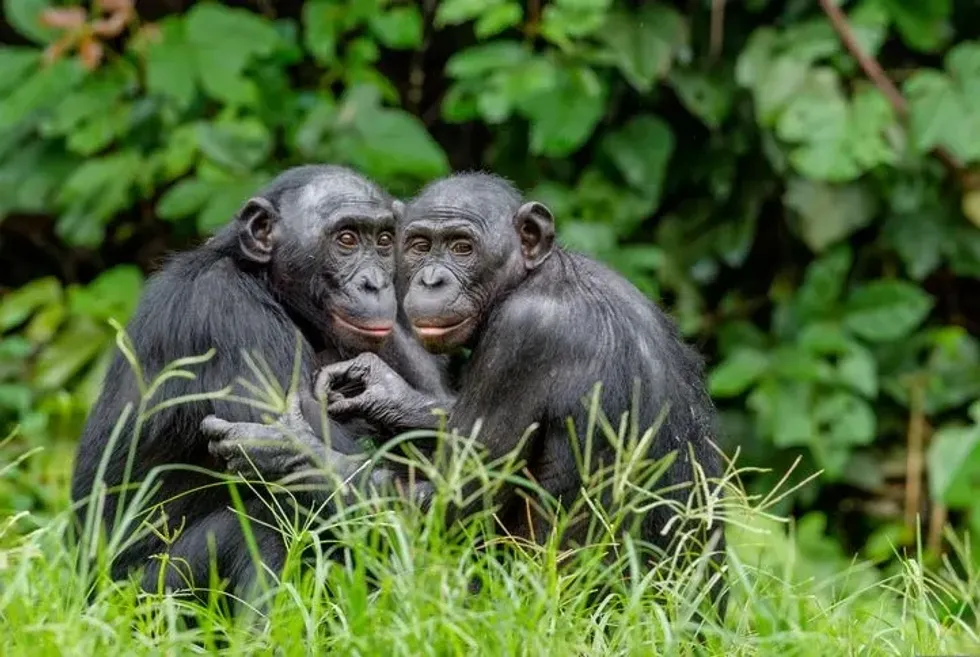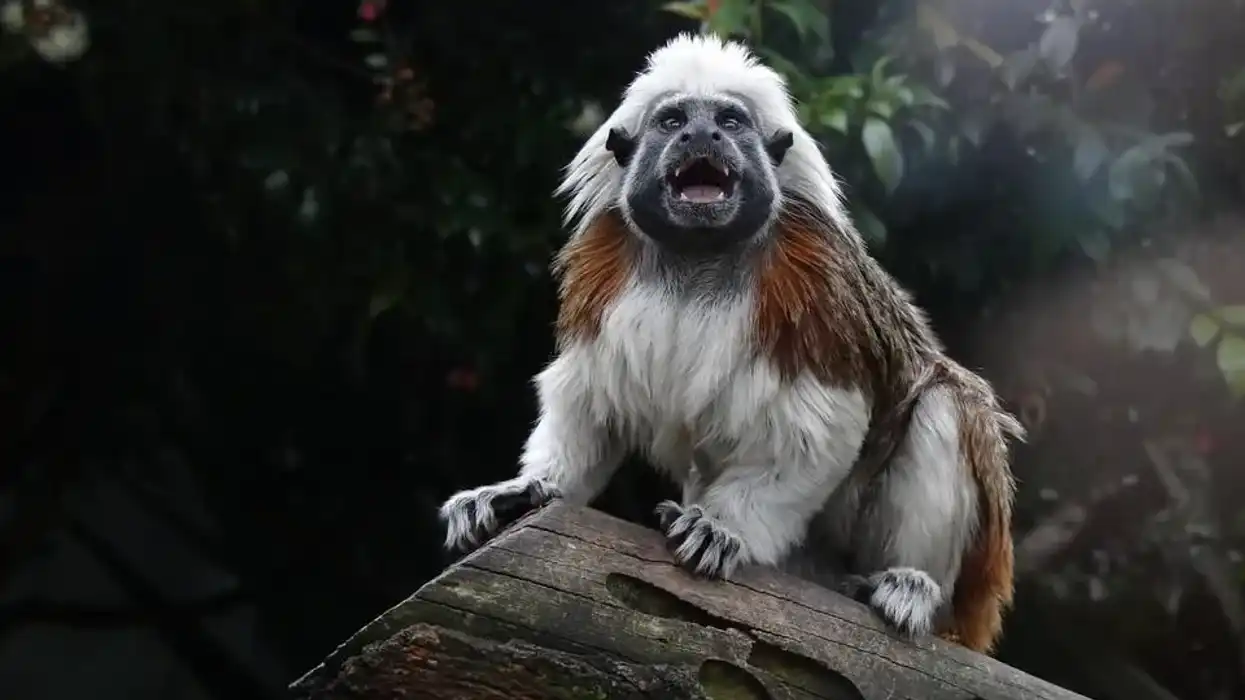Have you ever thought about the Great Apes that are close to our species? Let us talk about the Bonobo, which is one of the most talked-about ape species in the world of science.
The unique social bonds shared by the Bonobo population intrigue us to learn more about their ways. The Bonobo (Pan paniscus) mainly belongs from the Congo basin.
Formerly they were known as 'Pygmy Chimpanzee' and clubbed together with the broader Chimpanzee group. However, since then, they have been separated as a separate population from that Chimpanzee.
Bonobo females share an equal status with the males, which makes them distinct in the world of wildlife. Bonobos have an omnivorous diet, but their main food source is leaves, shoots, and fruits. They like to look for their food in the nearby areas rather than doing hunting expeditions.
Currently, the Bonobo is listed as 'Endangered' in the conservation list of the International Union for Conservation of Nature because it constantly faces the threat of habitat loss. The troubling civil circumstances of Congo have made the wildlife habitat of the Bonobo very unsafe.
Keep reading to know more about the Bonobo facts. Also, don't forget to check out the articles about patas monkeys and Capuchin monkeys.
Bonobo Interesting Facts
What type of animal is a bonobo?
The bonobo (Pan Paniscus) is a part of the Great Apes that is closest to us human beings.
What class of animal does a bonobo belong to?
The bonobo belongs to the class 'Mammalia' and the order 'Primates'.
How many bonobos are there in the world?
According to the World Wildlife Trust, the Bonobo population around the world is around 10,000 to 50,000 individuals. However, the African Wildlife Foundation states that there are around 15,000 to 20,000 individuals left in the wild. They go on to say that only 30% habitat of the bonobos has been studied thoroughly.
Hence, there is no exact data for the numbers of bonobos that inhabit our world. Their wildlife population is currently enlisted as 'Endangered.' Hunting for bonobos is currently banned.
Where does a bonobo live?
Bonobos live in the rainforests of the Congo basin that is situated to the South of the Congo river.
What is a bonobo's habitat?
Bonobos enjoy living in forest areas, and they are endemic to the Southern part of the Congo river. They like to live between old fruit-bearing trees that grow tall. One of the most interesting things about Bonobos is their way of making nests between the trees.
It is almost like the human behavior of building houses. Many Bonobos are also known to share nests.
Bonobos are ground dwellers as well as arboreal in nature. So, you can definitely spot them lazing away on a treetop. Lots of trees in their habitat give the Bonobo groups the opportunity to jump from one tree to another.
Who do bonobos live with?
Bonobos live with their families consisting of the adults and the young. Male bonobos usually live with the family where they are born, whereas female bonobos may often migrate to other groups. The mother is an important part of the bonobo family.
Mother bonobos have strong bonds with their sons, and they end up protecting the male bonobo apes if they get in trouble. Females also play a central role in making important decisions for the troops.
A single group of bonobos can have more than 100 individuals. The young bonobos are loved and cherished by the community after their birth. Females also form central points in the matriarchal groups.
How long does a bonobo live?
In captivity, the average lifespan of a bonobo monkey is anywhere around 40 - 50 years. Not much is known about the lifespan of the bonobos living in the wild forest areas of the Democratic Republic of Congo.
How do they reproduce?
Bonobos are known for their sexual traditions. A female member of a group will often mate with multiple male members of the family.
Females are also known to mate with those males that show respect towards them. After humans, bonobos are the only animals that take part in face-to-face sexual activities. The gestation period of bonobos lasts for 240 days.
Female bonobos even go through long oestrus periods and show external signs of it. The oestrus periods may stop for one or more years after a female Bonobo has given birth.
Bonobos maintain a four-and-a-half-year gap between having infants, as the young bonobos may depend on their mothers for four years. The mother takes time and bonds with her children.
She also has the duty to teach the social customs and duties of the bonobo group. It takes six to eight years for a bonobo to reach sexual maturity. However, the adult female bonobo doesn't have infants until she is 13 years of age.
Sex is predominant in the bonobo culture, and they engage in sexual activities to create strong bonds. Homosexual relationships and bonding have also been seen in these animals.
What is their conservation status?
According to the International Union for Conservation of Nature (IUCN) Red List, the bonobos are 'Endangered.' The population of this subspecies of apes faces threat mainly from the humans as they keep on encroaching the last.
Along with that, the life of bonobos has been severely affected by the constant wars taking place in the Democratic Republic of Congo. Many bonobos are also poached as bushmeat in the Congo basin.
Bonobo Fun Facts
What do bonobos look like?
Bonobos are called 'pygmy chimpanzees' because of their similar look. However, bonobos have a much more slender body. Among all the great apes, bonobos are one of the species that are most used to bipedal walking.
They are known for using their hind legs to travel around the forest. Bonobos also have narrow shoulders compared to that chimpanzees. The bonobo vs chimp debate may go on as there is no certain solution to it.
Bonobos also have long legs that are muscular to help them in walking and traveling. The bodies of bonobos are converted with black hair-like fur, and they have dark facial features.
The distinct bright red or pink lips of a bonobo ape don't fail to stand out. Bonobo teeth are straight and even give the animals a glorious smile. Humans and Bonobos share 98.7% of their DNA.
How cute are they?
Bonobo monkeys are quite like us, so it might be a grave sin not to call them cute. Bonobos are in fact very cute with their open smiles along with their bubbly and peaceful personalities.
How do they communicate?
Bonobos are very intelligent animals, and they have unique ways of communicating with each other in their habitat. Bonobos can even use symbols to communicate with the members of their groups. In Captivity, humans have been able to teach them a lot of communication techniques.
However, in a Bonobo animal, the predominant way of communication is through body movements. They even use a hooting call to communicate with others. They have five or more call types to communicate with the peers.
How big is a bonobo?
A Bonobo tends to have a standing height of 28 in - 35 in (71 cm - 89 cm) when they are on their hind legs. The nose to rump length of a Bonobo is 28 in - 33 in (70 cm – 83 cm).
They are only slightly smaller than Chimpanzees that can have a length of 25 in - 37 in (63 cm – 94 cm).
How fast can a bonobo run?
Bonobos can have a running speed of 25mph (40km/hr). Bonobos are great on their hind legs which makes them a tad bit closer to humans.
How much does a bonobo weigh?
The average weight of an adult bonobo is 68 lb - 86 lb (30 kg - 40 kg). The species is known for their slender bodies, so the weight is well distributed.
What are their male and female names of the species?
There are no distinct names for the males and females of the bonobo species.
What would you call a baby bonobo?
The baby of the Bonobo species is known as an infant.
What do they eat?
Bonobos are known as 'omnivorous frugivore'. Most of their food consists of leaves, bark, fruits, and other herbivorous food products. However, they may also feed on small vertebrates and mammals from time to time. Unlike chimpanzees, bonobos do not actively go hunting for meat.
Bonobos are often seen as solitary hunters or foragers rather than participating in groups. Moreover, bonobos are known for sharing their food with their groups as well as with strangers. Bonobos can even make a wooden toothpick to get rid of gunk from their teeth.
Are they loud?
Bonobos can be loud went they are making long-distance call sounds.
Would they make a good pet?
Bonobos are extremely intelligent animals. Apart from living in the wildlife, they are known for quickly bonding with humans.
However, these wild animals are endemic to the Democratic Republic of Congo. Hence, it would be illegal to keep a species that are at the threat of being extinct. Many bonobos are housed in zoos that help you to have a look at these wild animals that are so close to us humans.
Did you know...
The word Bonobo might come from the word 'Bolobo' which was a village in the Democratic Republic of Congo where the scientist first came contact with a population of the Great Ape species. Bolobo might stand for the gurgling sounds made by the Congo river.
The phonetic Bonobo pronunciation is 'buh · noh · boh'.
The Wild Bonobos of the Congo forests play an important role in scattering the seeds of different plants.
The laugh of a bonobo is similar to that of a human baby.
Are humans closer to chimps or bonobos?
Both chimpanzees and bonobos are part of the Great Apes, and they equally share 98.7% DNA similarities with humans. Scientists are still trying to figure out the ways in which one species might be closer to humans compared to the other.
Bonobos were thought to be subspecies of chimpanzees, and they were known as 'pygmy chimpanzees.' However, they were later given a division of their own.
Bonobos do share quite a bit of similarity with the human species. They care for their offspring just like us, and they also mate in a way that is similar to humans.
Like humans, the bonobo females are powerful, and they also have matriarchal societies.
The mother-son relationship that the bonobos share is very similar to that of humans. Chimpanzees are known to be aggressive with their young, while a bonobo is often known for their peaceful behavior.
More studies need to be done on the social similarities shared by humans and bonobos as it might give us some clue about our relationship with apes and even chimps. Science may show us the path of how several years ago, the bonobos and chimpanzees may have been equal to us.
What are Bonobos known for?
Bonobos are known for the unique bond that they share with their offspring. The bonobo mother bonds with the child right from birth.
Bonobo behavior includes a calm and composed attitude. Mutual respect is important in bonobo society, and the high status of females makes them an ape that we need to study in detail.
One of the most interesting bonobo monkey facts is that the species kiss to show affection. The bonobo society is quite complex, so this bond shared by the males and females of the population has always been an interesting topic to study.
Here at Kidadl, we have carefully created lots of interesting family-friendly animal facts for everyone to discover! Learn more about some other mammals including the pygmy marmoset and the Asian palm civet.
You can even occupy yourself at home by drawing one of our hugging monkeys coloring pages.








